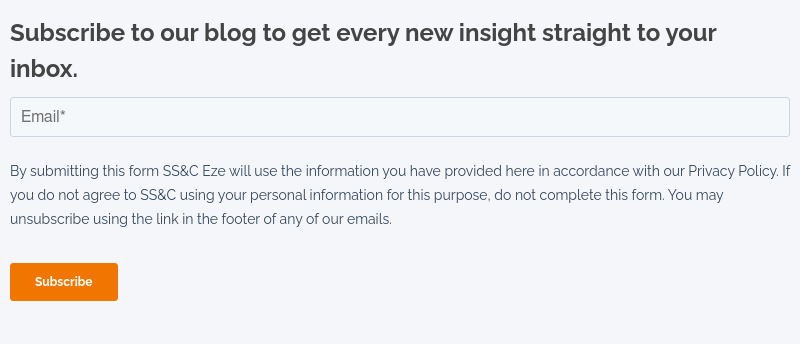The good news is that you do not have to do an extensive, all-encompassing audit to understand if your technology is up to the job. Engaging in a smaller, informal technology assessment can still provide insight into whether you have the technology you need to succeed.
In this post, I’ve distilled lessons I’ve learned throughout my twenty years on the buy side – and helping buy-side firms find the right technology – into five simple steps. These steps will help you determine whether your current investment technology vendor is in alignment with your firm’s goals – and what to do if they are not.
Not sure you need an assessment? Find out in this 4-question quiz.
5 Steps for Conducting an Investment Technology Assessment
1. Define Your Firm’s Vision
Before diving into any assessment, you must define your current and future business priorities, including where your firm will be in two, three, and five years.
Start by considering your current competitive advantages; what does your firm do better than the rest? What could it do better? Consider what you do well today and what you’ll need to add to grow in the future.
Once this list is defined, the big question is whether your current technology vendor is helping – or hindering – your firm's vision. To achieve the future you envision for your firm, you need to start laying the technological foundation today.
2. Evaluate the Functionality of Your Investment Technology
Too often, firms resign themselves to the less-than-ideal configurations, workflows, and accessibility of their current systems, incorporating workarounds and "making do." While these tactics may get the day's work done, they do nothing to advance the firm's long-term goals.
To determine if your technology is keeping up with your firm, here are some specific questions you can ask:
-
Does your system meet the workflow needs of your operation? Does it have the views and analytics you need to execute effectively and efficiently? If not, you will not only slow down your operation, but you’ll also slow the growth of your firm.
-
Can the system support the compliance rules necessary to satisfy investor mandates and meet changing regulatory requirements? As these requirements continue to evolve and grow in complexity, you need the confidence of knowing that your technology keeps your firm in compliance.
-
How difficult is it to configure the technology to fit your front-to-back-office workflows? Can you change the workflows yourself, or do they require custom work? Be aware that custom work requires extra time and money that can impact your ROI and your firm’s ability to expand.
-
Can your traders view all the information they need in a single dashboard, or do they have to navigate between screens, putting them in the dreaded “swivel chair?” Swiveling back and forth wastes valuable time that could otherwise be spent executing investment ideas – and getting your firm ahead.
-
How many clicks does it take to process and allocate an order? Keep track and multiply those clicks by the number of times you do them daily. These small things can add up to inefficient processes that put your firm behind the competition.
-
Does your current vendor offer the flexibility of seamless browser, desktop, and mobile access? When your access is limited, your ability to capitalize on opportunities will also be limited.
3. Review Your Vendor’s Service and Support Offerings
Service and support are other areas where I see many firms “making do” with their technology vendor. With so much on the line, you need a vendor who will be there when you need them today while supporting your growth for the future.
When you work with your vendor’s service team, do you feel confident they have the expertise and experience to help you with whatever challenges you may face? Do you feel confident that the person you are talking to knows the technology, the industry, and the demands of your business?
Are you getting one-to-one support from your vendor when you need it, or do you struggle to get in contact with anyone from your support team, sometimes not hearing back for hours – or even days? Some vendors will take a tiered approach, servicing their highest-value customers first while other clients wait.
And when you do get in touch, are you shuffled around from team to team, explaining your issue repeatedly? Unanswered service calls and having to start over with each new service rep wastes time your firm cannot afford.
As you plan to grow, is your vendor there to help you? For example, do they offer managed or strategic services to help your firm navigate new business challenges, projects, initiatives, or augment existing resources?
These managed services are also helpful if you want to offload critical business activities without the cost and hassle of onboarding an additional third-party vendor or increasing headcount.
4. Calculate Your Investment Technology’s True Total Cost of Ownership
Cost is another critical area to evaluate in an audit of your investment technology. The trouble is many firms are not aware of the true total cost of their existing system.
Here is a simple framework for uncovering both the true total value and true total cost of your technology. The calculation is relatively simple but will require some analysis.
To start, look at your firm’s basic requirements, the baseline features, and the capabilities you’d expect from any investment technology provider. Is your current vendor able to meet your basic requirements? Or are you supplementing with other solutions? If you are, make note of those additional costs.
Next, it’s time to do some digging. Review your most recent invoice from your vendor and check for any “hidden” or unexpected fees. These fees – such as upgrade and maintenance costs, support and training costs, or customization or integration costs – can add up over time. Add to that the cost to your business of inefficiencies, and your system may be costing you more than you think.
Hidden values are often more difficult to quantify but are nonetheless critical to the analysis of the cost of your technology. These values, like R&D commitment, scalable service, access to third-party applications, and the reputation and tenure of your vendor’s teams, can greatly enhance the value of your technology. Take a moment to make note of any of the hidden values your vendor offers.
Only by factoring in the hidden costs and hidden values your investment technology provider offers can you truly understand how much your technology is costing you – or how much you might save or have to gain by moving to a new vendor.
Dive deeper into your technology's total cost of ownership and implementing cost-saving strategies in this guide.
5. Analyze Your Results & Determine Next Steps
Once your assessment is complete, analyze the results. If one or more of these areas is not providing satisfactory answers, it may be time to look for a new investment system. Because over time, inefficient technology, services, and support will not only cost you time and money, it can threaten your credibility with your clients. And while other firms surge ahead, yours will lag.
If this is the case, your next steps should be to find a technology partner that understands the demands and vision of your firm, one with the experience needed to guide you through the switching process and into a new era of alignment with your investment management technology and achieving your goals.
Adaptation is Imperative to Growth
Whether it’s the markets, technology, or careers, the rapid pace of change makes the investment management industry exciting – but only if you’re able to adapt along with it.
Throughout my career, I have benefitted from working for top Wall Street firms and buy-side technology companies. I’ve held roles as senior relationship manager, capital markets at eClerx, buy-side sales and head of midwest and west coast hedge funds at Broadridge, and most recently, senior vice president of business development at Enfusion.
Through these experiences, I saw first-hand that the most successful organizations are the ones with the ability to thrive through change.
That's why I chose to work at SS&C, selling the best OMS and accounting technologies in the industry. Eze OMS and Advent Geneva have a rich history of adapting and growing to best meet the evolving needs of the investment community.
With decades of experience, a massive, well-funded R&D infrastructure, and a broad range of technical solutions brought together by some of the best technologists across the wealth and investment management industry, our organization has the vision and technology to grow alongside our clients’ front-, middle-, and back-offices.
Additionally, SS&C Eze solutions are supported by 500 globally dispersed service experts. This team has the tenure and expertise needed to advise investment firms on best practices, ensure your business processes are optimized, or help you quickly navigate roadblocks and issues – all within minutes, not days.
The new year will certainly bring more changes. But with changes comes opportunity, and I am excited to be part of an organization with the technology and service needed to meet the demands of our clients, whatever the market brings.
Ready to Take the Next Step in Aligning Your Investment Technology with Your Firm’s Vision?
Is your investment firm ready for a new kind of vendor partnership?
At SS&C, we have a demonstrated history of keeping our promises and making the highest levels of investment in technology, service, and innovation. Learn the difference this type of vendor partnership can have on your firm’s operations.





